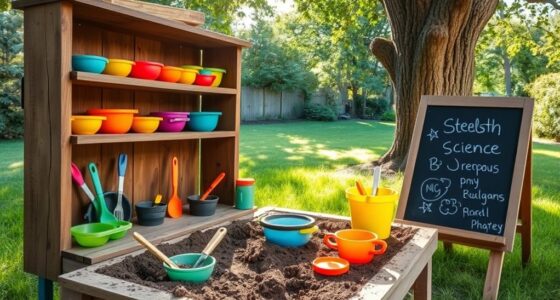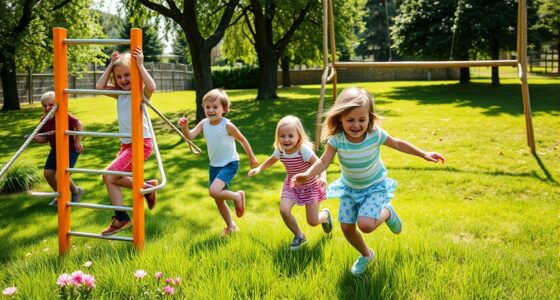Urban nature play transforms spaces like parks, balconies, and courtyards into lively environments where kids can explore, imagine, and connect with nature. By engaging in gardening, storytelling, and outdoor activities, you help children develop curiosity, patience, and environmental responsibility. Community gardens and green spots turn neglected areas into vibrant hubs of discovery and social bonding. Want to discover more ways to bring nature into urban settings? Keep exploring to find out how you can make a difference.
Key Takeaways
- Urban nature play transforms parks, balconies, and courtyards into engaging outdoor spaces for children’s exploration and imagination.
- Community gardening in these areas fosters environmental stewardship, teamwork, and a sense of ownership among children and families.
- Garden therapy offers mental health benefits, teaching patience and mindfulness through nurturing urban plants.
- Incorporating natural elements in city spaces enhances sensory experiences and promotes well-being for children and communities.
- Urban nature play supports sustainable development by turning neglected areas into vibrant ecosystems for learning and growth.

Urban nature play transforms city spaces into vibrant environments where children can explore, imagine, and connect with the outdoors. It’s about turning everyday areas—parks, balconies, courtyards—into lively hubs of discovery. One of the most effective ways to foster this connection is through garden therapy and community gardening. These activities do more than just green up a space; they provide children with hands-on experiences that nurture curiosity, patience, and responsibility. When you introduce gardening into urban settings, you’re offering kids a chance to witness nature’s cycles firsthand, from planting seeds to watching them sprout and grow. This tactile engagement encourages learning about ecosystems, sustainability, and healthy eating, all within the city environment.
Community gardening plays a key role in urban nature play because it transforms neglected or underused areas into shared green spaces. When you participate in or support local community gardens, you help create a sense of ownership and pride among children and families. They become active contributors rather than passive observers, learning the value of teamwork and stewardship. Children can dig, plant, water, and harvest, gaining a deeper understanding of how food grows and the effort involved. These gardens serve as outdoor classrooms, where lessons extend beyond textbooks into real-world applications. Plus, they foster social bonds, breaking down barriers and encouraging diverse groups to work together around a common goal.
Supporting community gardens transforms neglected spaces into shared green havens that foster teamwork and environmental responsibility.
Garden therapy, often used to support mental health and well-being, is especially impactful in urban settings. As you involve children in garden therapy activities, you help them develop a calming relationship with nature, reducing stress and building resilience. The act of nurturing plants can be incredibly soothing, teaching patience and mindfulness. It’s also a way to introduce children to the therapeutic benefits of nature, which they can carry into their everyday lives. When kids feel connected to their environment—whether through planting flowers on a balcony or tending a small vegetable patch—they develop a sense of agency and belonging. This connection is essential in bustling cities, where natural escapes are limited. Incorporating natural textures and materials into urban gardens can enhance sensory experiences and deepen their connection to nature.
In essence, integrating garden therapy and community gardening into urban spaces transforms concrete jungles into thriving ecosystems of learning and growth. It invites kids to step outside, get their hands dirty, and experience the joy that comes from nurturing life. Through these practices, city dwellers can foster a love for nature that lasts a lifetime, enriching both individual well-being and community spirit. You’re not just creating a playground; you’re cultivating a sustainable, lively environment where children can thrive amid the urban landscape.
Frequently Asked Questions
How Can Urban Residents Create Sustainable Nature Play Areas?
You can create sustainable nature play areas by incorporating native planting, which supports local ecosystems and reduces maintenance. Get your community involved to share ideas, volunteer, and help maintain the space. Use eco-friendly materials and design features that encourage exploration while minimizing environmental impact. Regularly educate residents about the importance of native plants and conservation efforts, ensuring the space remains vibrant, sustainable, and a true haven for play and nature.
What Safety Guidelines Are Recommended for Urban Nature Play?
Think of your play area as a safe harbor where wildlife encounters are lessons in respect. Always supervise children, and guarantee hazardous materials are out of reach. Check for sharp objects or debris that could harm little explorers. Keep the space clean and free of toxic substances, and educate kids about respecting nature’s creatures. By doing so, you create a haven where play thrives safely amidst urban greenery.
How Does Urban Nature Play Impact Mental Health?
Urban nature play boosts your mental health by offering nature immersion, which helps reduce stress and anxiety. When you engage with outdoor spaces, you activate your senses and reconnect with nature, providing a calming effect. This stress reduction can improve your mood, focus, and overall well-being. Whether on a balcony or in a park, making time for nature play allows you to recharge emotionally and mentally.
What Are Budget-Friendly Ideas for Urban Nature Play Spaces?
You can create budget-friendly urban nature play spaces by setting up DIY installations like simple bird feeders, small rock gardens, or recycled planters. Consider starting a community garden where neighbors can grow flowers and vegetables together, fostering connection and nature interaction. These ideas require minimal investment, are easy to maintain, and bring natural play and relaxation to your urban environment, making nature accessible and enjoyable for everyone.
How Can Urban Communities Encourage Children to Engage With Nature?
Imagine planting seeds of curiosity in young minds; you can do this by encouraging children to explore nature-inspired art and participate in community gardening. These activities act as bridges, connecting kids to the natural world, even in small urban spaces. By fostering hands-on experiences, you turn everyday environments into vibrant classrooms, inspiring children to appreciate and engage with nature deeply and meaningfully.
Conclusion
As you step into your city’s parks, balconies, or courtyards, imagine the soft grass under your feet, the warm sun on your face, and the gentle buzz of nature around you. These vibrant pockets of greenery become your escape, where you can breathe deeply and reconnect. Embrace these small outdoor havens, and let their simple beauty remind you that even in the busiest cities, nature’s playfulness is always just a step away.









